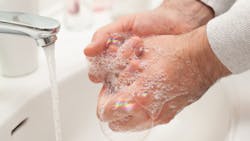Updated guidance published on hand hygiene in healthcare settings
Five medical organizations are recommending updated best practices for hand hygiene to protect patients and staff in healthcare settings. The recommendations emphasize the importance of healthy skin and nails and easy access to alcohol-based hand sanitizers.
Strategies to Prevent Healthcare-Associated Infections through Hand Hygiene: 2022 Update, one in a series of expert guidance documents known collectively as the Compendium, was published in the journal Infection Control & Hospital Epidemiology.
“Hand hygiene is a basic function of healthcare safety,” said lead author Janet Glowicz, PhD, RN, CIC, with the Centers for Disease Control and Prevention. “By engaging healthcare personnel and establishing reliable processes described in the Compendium, we can achieve effective, consistent hand hygiene. Commitment by healthcare leadership is also necessary to establishing a culture of safety.”
The document addresses how facilities can train healthcare personnel in proper technique, monitor their compliance, engage them in the selection of products to keep their skin healthy, and properly use gloves. It also discusses where facilities should place and how they should maintain alcohol-based sanitizer dispensers and sinks.
The guidance reviews the evidence around nail polish, gel, and shellac, which shows that short, natural nails with standard polish or no polish are easiest to clean. The authors found no new evidence specific to chipped nail polish and artificial nails but note previous findings that they can harbor germs. The guidance leaves specific policies about nail polish, gels, shellac, and artificial nail extenders to the discretion of infection prevention programs at each facility, with the exception of policies for those who scrub for surgery or work in high-risk areas. These personnel should maintain short, natural fingernails free of polish and nail extenders.
Citing research that shows only 7% of healthcare personnel effectively clean the entire surface of their hands, the guidance recommends ongoing training in handwashing and proper use of sanitizer. Thumbs and fingertips were most frequently missed.
The authors recommend that healthcare personnel not be routinely provided with individual, pocket-sized hand sanitizers and emphasize that hand sanitizer dispensers always be widely available and never prohibited, even in situations when washing with soap and water are indicated. When healthcare personnel suspect organisms that are difficult to remove, such as C. difficile and noroviruses, healthcare personnel should wear gloves and follow structured techniques for hand washing and hand sanitizing. In addition, facilities should not top-off sanitizer dispensers meant for single use or provide antimicrobial soaps that contain Triclosan. Facilities also should discourage the use of double gloves, except in certain circumstances.
To encourage compliance and to support healthy skin and nails, facilities should include healthcare personnel in the selection of hand sanitizers and moisturizers, while ensuring the products are compatible with antiseptics and gloves used on site. Maintaining healthy skin is a crucial element of hand hygiene.
Surgical settings require special care, but waterless hand hygiene with surgical hand rubs is acceptable, especially as it improves compliance. Brushes should be avoided in surgery prep due to their negative impact on skin health.





